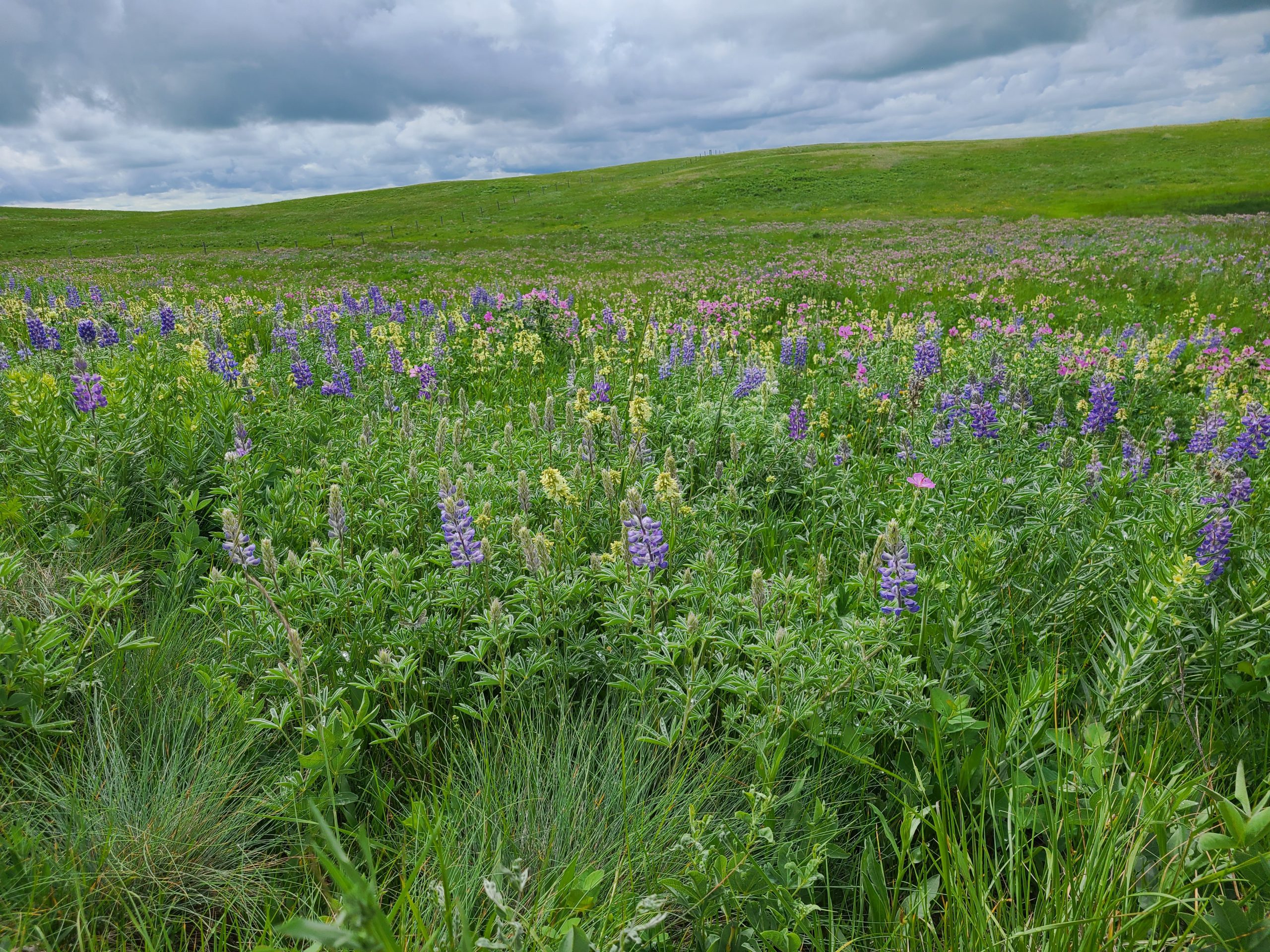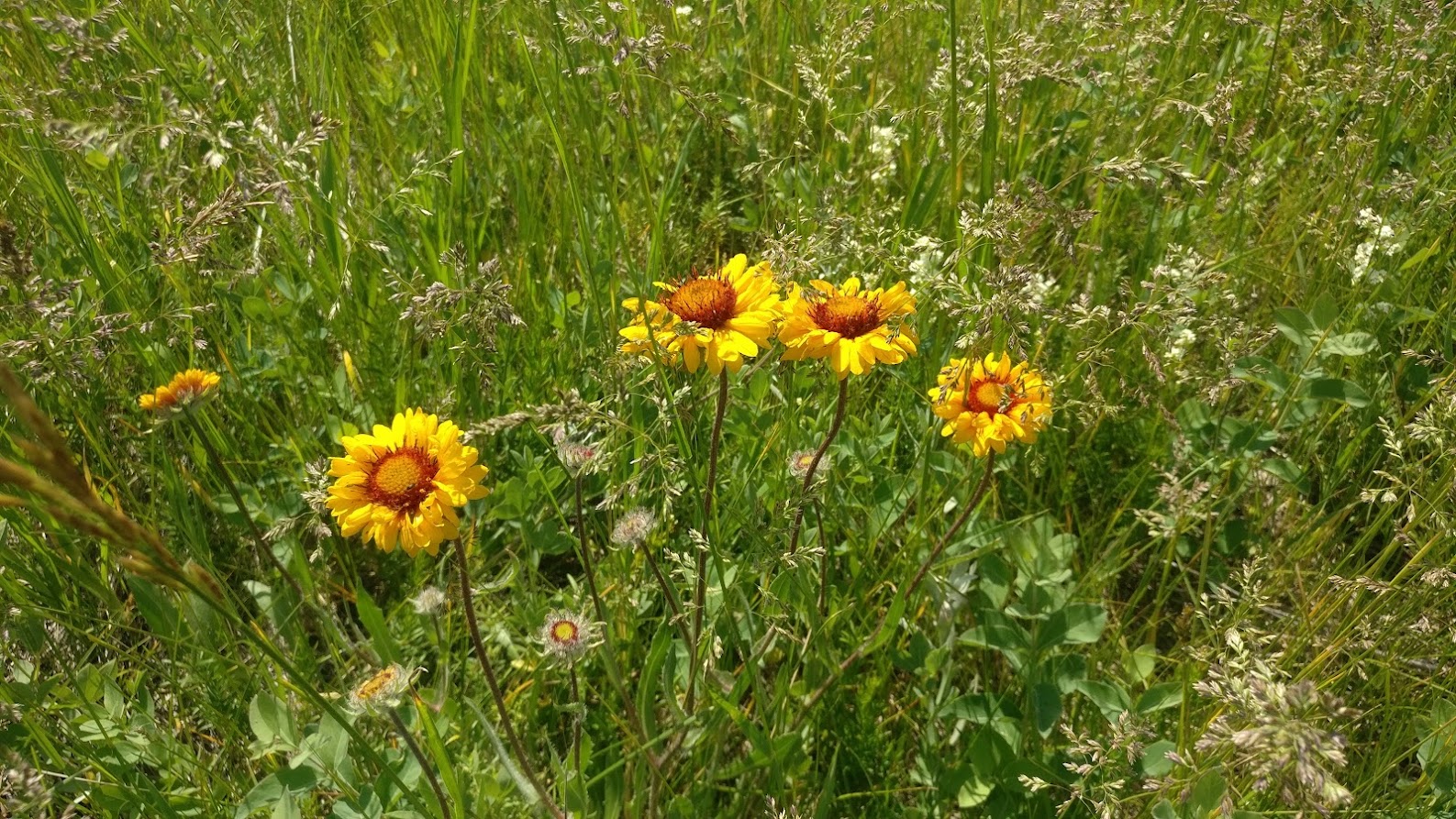
On Human Health and Plant Diversity: The Value of a Prairie
August 23, 2024
- •
- •
- •
The plants of the Canadian prairies provide much more than beauty.
By Ruiping Luo
Read the PDF version here.
Sunrise is a wash of colour, reds and blues that creep across the open plains. The soil rouses beneath the radiance, rejuvenating roots that have been waiting for just this moment. Soon, new growth will unfurl, green shoots pushing through the dry stalks left from previous years, reaching for every photon of light they can catch. A few months more, and brilliant red-yellow blooms will be visible, standing defiant against sun, rain, and wind.
The plants of the Canadian prairies provide much more than beauty. They help to filter toxins from the air, water, and soil. They provide soil organic matter, cultivate microbes, store carbon, and improve soil fertility. They also mitigate floods, droughts, and fires by supporting water entry into soil, and provide habitat for many beneficial insects, birds, and other animals. These activities present a clean, healthy, and diverse environment, essential for human health and well-being.
From traditional medicines to modern chemistry
Prairie plants can also benefit human health more directly, as medicine. Native plants have been used by many Indigenous cultures to treat a variety of ailments. For example, the bright flowers of Gaillardia aristata, a plant common to flat areas under full sun, were used by the Blackfoot or Niitsitapi peoples to produce medicine for sunstroke or heatstroke, and roots were harvested to improve digestion.
“Globally, it’s been demonstrated a number of times that there is knowledge about our planet, and that is called traditional knowledge,” Dr. Roy Golsteyn, a professor at the University of Lethbridge, explained. His lab, the Natural Product Laboratory, specializes in investigating the biochemical properties of prairie plant species and, in parallel, works with Indigenous communities to better understand these unique plants.
Until now, western science has largely neglected the prairies. Grasslands, also known as prairies or steppes, are found on every continent except Antarctica, covering an estimated 20 to 40 percent of land globally, yet are one of the least studied ecosystems for plant biochemistry. The Natural Product Laboratory intends to address this extensive knowledge gap by investigating native prairie plants, including Gaillardia aristata, and has built a unique database of prairie plant extracts.
Already, they are finding many new and interesting chemicals, some of which may lead to new treatments. For instance, they found that compounds extracted from G. aristata inhibit mitosis in human cancer cells and could lead to development of new ways to treat cancer. By examining prairie plants, Golsteyn and his lab are finding novel compounds that could vastly broaden our understanding of biochemistry.
Biochemistry in the fight for survival
Prairie plants need to survive some of the most extreme conditions in the world. Temperatures on the open plains in Canada have reached 40°C and dropped as low as -45°C. With few trees to provide shelter, wind speeds can exceed 140 kilometres per hour, and heavy rains alternate with weeks of blazing sun. Conditions here change rapidly; temperatures can rise or fall 20°C in only a few hours. With drought, floods, fires, and herbivores adding to the list of threats, survival is a constant battle.
Over generations, native plants have adapted. To thrive in these conditions, Gaillardia aristata has developed long, narrow leaves and deep taproots, which support the plant through drought and strong winds. Like other plants that must contend with the harsh environment, these flowers have also developed chemical traits, such as metabolites to discourage herbivores from consuming their leaves, or hormones that regulate flowering and growth. Given the exceptional range of stressors on the prairies, it is hardly surprisingmthat prairie plants develop an exceptional range of biochemical responses.
“These [temperate steppe] zones together,” Golsteyn said, referring to grasslands throughout the world, “just generate a tremendous amount of chemical diversity that gives them a resilience to abiotic diversity.”
From that diversity, we find a trove of chemicals, any of which might prove beneficial for people. And unlike synthetic chemistry, which is created in labs, using natural product chemistry from plants could involve fewer risks.
Natural products evolved as part of the environment. These products are mainly produced by proteins, such as enzymes, and are well-adapted to working inside of cells. Because they evolved with the ecosystem, the system can disassemble these chemicals, and they often do not linger in the environment. In contrast, synthetic chemicals are compounds the ecosystem may not have dealt with before, and it can be difficult to predict how these chemicals will react in a natural system. Synthetic chemicals are more likely to cause unexpected side effects and to build up in an ecosystem. As a result, natural products are often safer than synthetic chemicals, for both human and environmental health.
Luckily, nature has already made a vast number of chemicals, many of which we have yet to explore. In particular, the prairies still hold countless intriguing mysteries.
Asked about why he chose the grasslands, Golsteyn responded, “Other areas of the world of course are interesting, but you get this massive diversity in this simple ecological system, and we think that’s why the chemistry is turning out to be so interesting.”
A disappearing world
However, even as our understanding of the prairies improves, the landscape itself is declining. Temperate grasslands are the most endangered ecosystem worldwide, and over 80 percent of Canada’s grasslands have been lost. Each year, an estimated 60,000 hectares, or 600 square kilometres, is converted for agriculture, urban expansion, or industrial development.
Alongside these landscapes, we are also losing the resident plants and the accumulated knowledge of this region. With so much about prairie plants still unknown, it can be challenging to assign a commercial value to these species. Still, some of the best medicines have come from natural products, and with the grasslands vanishing, we are depleting a repository of natural chemicals that formed over millions of years.
For some communities, it also means a loss of culture and well-being. Indigenous nations, which have lived on these lands since time immemorial, are seeing familiar plants disappear. With them, traditional knowledge, often intimately tied to the land, is also lost, along with the lifestyle and ceremonies these plants supported. The risk of knowledge loss is recognized by the United Nations and the Government of Canada, who, through the UN Convention of Biological Diversity are working to protect peoples who hold traditional knowledge and are connected to the land. More broadly, as native plants vanish, the services they provided end, threatening human health.
“Ecosystems are complex webs,” Golsteyn added. Missing even a few plants could have profound effects on the rest of the system. Especially in the prairies, where there remain many unknowns, we cannot predict all the effects that degradation of this crucial ecosystem will have.
The value of the prairies lies in more than colouful flowers and extreme weather. The value lies in ecosystem services that bolster human health and cultural traditions intricately associated with this land. It lies in a diversity of species and a range of chemical compounds we are only beginning to discover. We still have so much to learn from the prairies, though unless we work to protect this unique community, we could soon lose this irreplaceable ecosystem and all the surprises it contains.
Thank you to Jane Lancaster, plant biologist with Kestrel Research Inc. and coordinator of Grasslands Restoration Forum, for information on the growth, flowering, and adaptations of Gaillardia aristata. Thank you also to John McFaul, naturalist with Alpenglow Nature Hikes and Nature Calgary, for directing me to records of Indigenous medicinal use.

